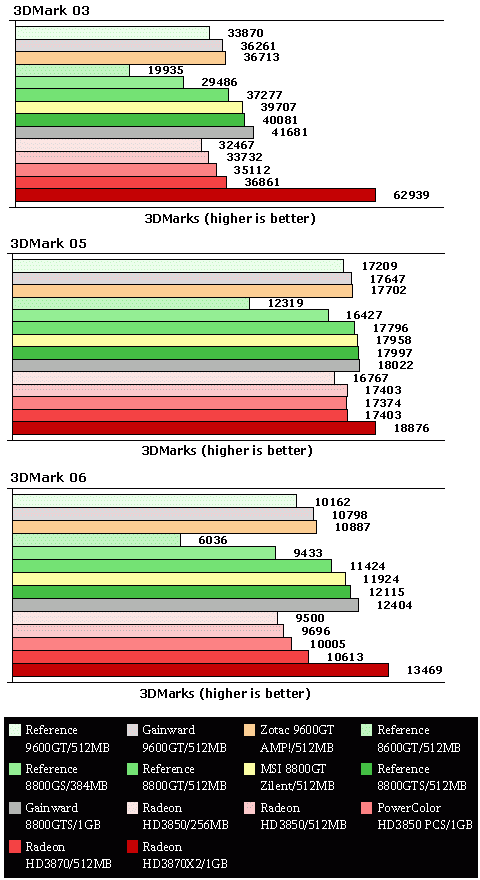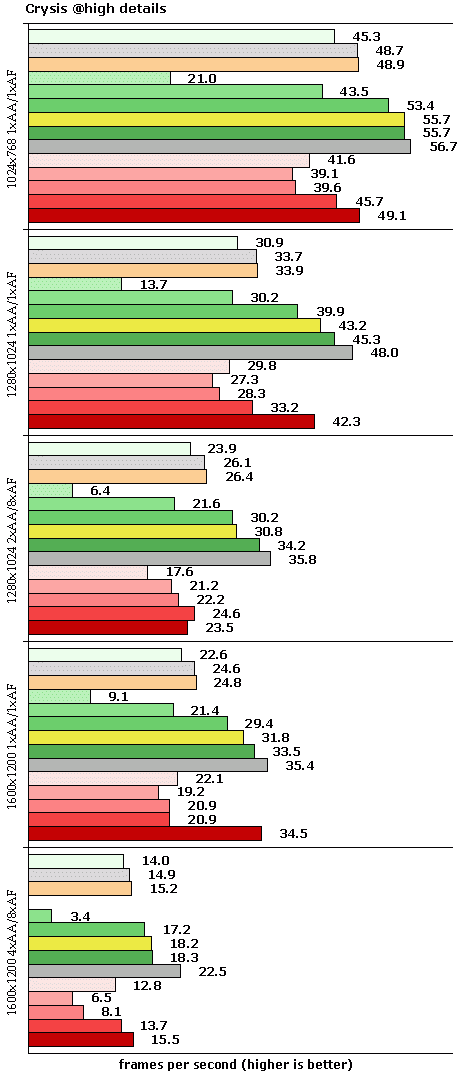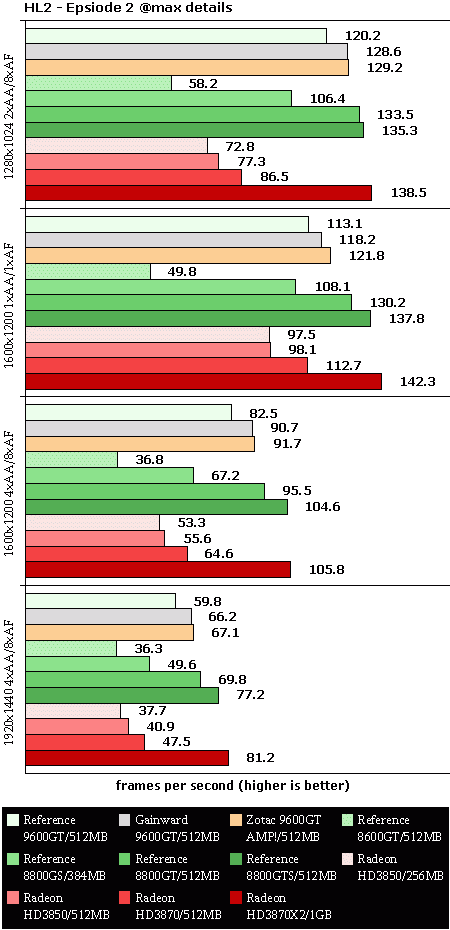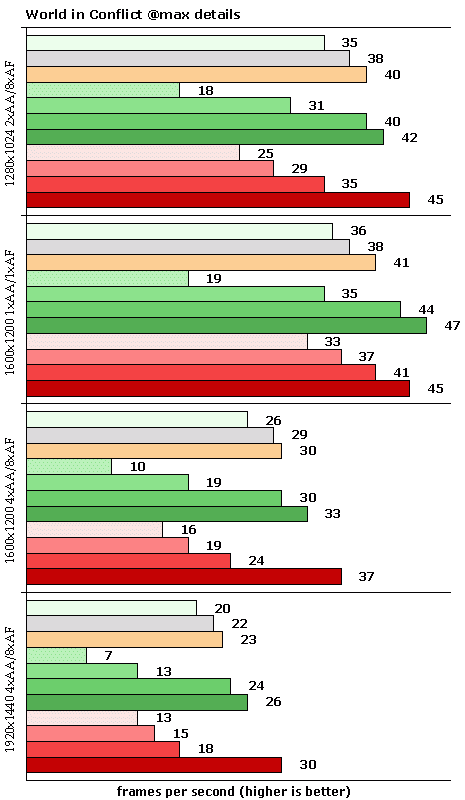
Review: Golden Sample with loads of potential
Last week Nvidia launched its G94, a new mainstream chip that's behind the new Geforce 9600 GT cards. Gainward went a step further, overclocked it and added a lot of multimedia features that this chip can support. The reference Geforce 9600 GT runs at 650MHz core, 1625MHz Shader and 900MHz memory speed. This was too slow for Gainward so they overclocked it to 700+MHz core and 1000+MHz memory (effective 2000+MHz).
Gainward’s “+” means that additional overclocking is possible, thus Gainward opted for their in-house cooler replacing the reference one. Shader speeds were overclocked to 1750MHz, 125MHz more than reference.

It was about time to see a successor to the year old Geforce 8600 (G84) generation. The old 8600 GT is outdated and Nvidia needed to fill the gap between 8600 GTS and 8800 GT. 8800 GS was a temporary solution since it already got its EOL (End Of Life), and anyone who owned it knows why we said it was just temporary. It used a G92 chip with less shader processors (96) and had the unusual 192-bit memory interface and 384MB of memory.
The Geforce 9600 GT we're looking at today is not based on G92, but rather on the new G94 chip that’s nothing more than crippled G92. It has half the number of Shader processors, 64 in total, whereas the G92 (8800 GTS) packs 128. We can’t help but agree with many enthusiasts that think how the name 9600 GT is not appropriate, and that it might bring about a lot of confusion. Consumers might actually think that it’s part of a new generation of Nvidia products.

Geforce 9600 GT packs less shader processors, so the chip surface, the number of transistors and the price have all been cut down. Nvidia had to increase the frequencies in order to stay in the game and hold on to the data processing power. This process can sometimes be risky, but since the G92 has excellent overclocking potential it is a sure thing. The new chip’s surface is 225 mm2 which is 35% less than 8800 GT’s chip’s surface. The smaller chip is a direct result of less transistors; this chip packs 505 million or 33% less than in G92.
A 256 bit memory interface coupled with 512MB of memory provides additional boost and it comes in handy when encountering today’s complex graphics and high resolutions. The previous mainstream generation, 8600 GT, had a slower 128 bit interface that’s now exclusive to low-end cards. We see that this card is powerful by simply comparing its memory properties that are on par with 8800 GT.
Geforce 9600 GT has a couple of improvements compared to G92 cards, and we’re talking about a better compression coefficient at higher resolutions within ROP units (an important part of the graphics pipeline). DisplayPort is also something that Nvidia features on their cards for the first time, but the implementation depends on the partners. Gainward was one of the first companies that embraced DisplayPort, whereas on the I/O side, they managed to cram HDMI port together with two DVI outs – something we really liked. The rest of the improvements feature Pure Video 2 engine that we also find on 8800 GT/GTS (G92) based cards.

Pure Video HD is a video engine integrated into the graphics core and intended for video processing acceleration. By taking care of video processing, the graphics card’s GPU takes the workload off of the CPU and lets it handle some other important tasks. What Pure Video HD engine exactly does is decode and improve the quality of low and high-quality content. Video processing is a tiresome task for any CPU so this definitely helps. You can and should improve the quality of HD video, and the 9600 GT cards’ engine now features additional post-processing image capabilities.
We’re talking about realtime dynamic color and contrast correction enabled from within the new ForceWare driver. An important feature for Vista lovers is keeping Vista Aero, because it doesn’t revert you to the main theme when HD Video is viewed (a problem you might’ve encountered when using software such as PowerDVD).
With Gainward BLISS 9600 GT GS, you also receive an optical S/PDIF cable as well as an internal S/PDIF cable that you might need in case you don’t have optical S/PDIF out. That means you’re all set for enjoying HD video and sound. Since the card has an HDMI port you can connect it directly to your HDTV, whereas DisplayPort will be enjoyed only by rare users who bought Dell’s 30 inch monitor.
In short, Gainward’s Geforce 9600 GT GS supports DirectX 10, Shader Model 4.0, OpenGL 2.1 and DisplayPort. It features a quiet dual-slot cooler with enough muscle to give you pleasant gaming and HD viewing experience. Let’s move on to testing where we see exactly how fast it is and whether it can handle the competition.
Geforce G92 is the new mainstream card, a successor to Geforce 8600, but thanks to great characteristics of its G94 graphics chip, this card's capabilities far exceed those of its predecessor. Gainward overclocked their 9600 GT card, and you’ll see that performance was significantly better than reference card’s.
Testbed:
Motherboard:
EVGA 680i SLI (Supplied by EVGA)
Processor:
Intel Core 2 Duo 6800 Extreme edition (Supplied by Intel)
Memory:
OCZ FlexXLC PC2 9200 5-5-5-18 (Supplied by OCZ)
while testing CL5-5-5-15-CR2T 1066MHz at 2.2V
PSU:
OCZ Silencer 750 Quad Black ( Supplied by OCZ)
Hard disk:
Seagate Barracuda 7200.9 80GB SATA (Supplied by Seagate)
CPU-Cooler:
Freezer 7 Pro (Supplied by Artic Cooling)
Case Fans:
Artic Cooling - Artic Fan 12 PWM
Artic Cooling - Artic Fan 8 PWM
ATI Driver:
Sample-R680_xp_vista_8-451-2-080123a
8-1_xp32_dd_ccc_wdm_enu_57717
Nvidia Driver:
169.21_forceware_winxp_32bit_english_whql
169.28_forceware_winxp_32bit_english_beta
171.16_forceware_winxp_32bit_english_ for 9600GT
Futuremarks
Gainward BLISS 9600 GT is second in line, followed by Zotac 9600 GT AMP. Zotac’s core runs at 725MHz but the memory and shader speeds are identical to those on Gainward’s card.

In the first tests we did, Geforce 9600 GT outperformed the Geforce 8800 GS. In 3DMark 06, 9600GT beat the 8800 GS with 384MB by 15%. Compared to the reference card in 3DMark06, Gainward’s 9600 GT GS was better by 6%, Zotac’s 9600 GT AMP by 7%, while 3DMark03 resulted in Gainward’s best score – 7% better than reference. 9600 GT’s results clearly show that the G94 processor scales well when overclocked.
In 3DMark06, the old 8600 GT was slower by up to 68% compared to reference 9600 GT.
Gaming

In Crysis, Gainward's overclocked 9600 GT GS handles higher speeds well and beats the reference 9600 GT by 10%. At “high” settings, Geforce 8600 GT with 256MB of 128 bit memory can’t handle Crysis, but that doesn’t mean that you can’t play games with it. At “medium” settings, 8600 GTS will prove to be enough for pleasant gaming. 8800 GT beat Gainward 9600 GT and Zotac 9600 GT AMP by 17% and the reference 9600 GT by 29%.

In F.E.A.R., the G94 chip on Gainward’s 9600 GT card put on quite a show. It ran on par with the 8800 GT, whereas it beat the reference 9600 GT by up to 11%. Radeon HD 3870 and 3850 cards ran slower.
Gainward’s and Zotac’s 9600 GT cards have the same memory and shader speeds, but we see that additional 25MHz on Zotac’s card brings 1-3 fps more.

The Geforce 8800 GS can stand up to a reference 9600 GT, but Zotac’s OC card runs up to 11% better. As we increased the resolution the 8800 GT increased its lead over our 9600 GT. In the initial phase the difference was 15% whereas the highest tested resolution results in almost 30% advantage over Gainward and almost 40% over reference 9600 GT.

On all the resolutions below 1920x1440, the new 9600 GT churns out double the performance of an 8600 GTS.

With no AA and AF, Radeon cards run much better and HD 3870 beats the 9600 GT. In other scenarios Geforce 9600 GT ran faster or on par with ATI's HD 3870. In World in Conflict, Gainward’s 9600 GT GS ran a bit slower than Zotac's 9600 GT AMP, whereas both cards were close to the 8800 GT.
Conclusion
Gainward BLISS 9600 GT Golden Sample is a card that packs a lot of multimedia outs. At the same time it’s one of the first cards that bring DisplayPort. The card is overclocked to 700+MHz core, 1750MHz shader and 2000+MHz for memory. To ensure that this card runs stable, Gainward used their in-house quiet dual-slot cooler.
This card is great for gaming and it’ll cost you around €175. It’s a great successor to 8600 GTS that slowly shows signs of time. Price/performance ratio is close to that on 8800 GT cards, so if you can’t spare enough money for an 8800 GT, we sincerely recommend a 9600 GT with 512MB of memory.
Gainward's 9600 GT GS card comes with all the cabling required to make this an excellent multimedia card, and if you ever decide on buying a DisplayPort monitor you won’t regret it as this card features DisplayPort too.
